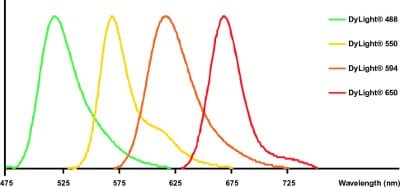Donkey Anti-Goat IgG H&L (DyLight® 488) preadsorbed (ab96935)
Key features and details
- Donkey polyclonal Secondary Antibody to Goat IgG - H&L (DyLight® 488), pre-adsorbed
- Conjugation: DyLight® 488. Ex: 493nm, Em: 518nm
- Host species: Donkey
- Isotype: IgG
- Suitable for: Flow Cyt, IHC-P, ICC/IF
Overview
-
Product name
Donkey Anti-Goat IgG H&L (DyLight® 488) preadsorbed
See all IgG secondary antibodies -
Description
Donkey polyclonal Secondary Antibody to Goat IgG - H&L (DyLight® 488), pre-adsorbed -
Host species
Donkey -
Target species
Goat -
Specificity
By immunoelectrophoresis and ELISA this antibody reacts specifically with Goat IgG and with light chains common to other Goat immunoglobulins. No antibody was detected against non immunoglobulin serum proteins. Reduced cross-reactivity to chicken, horse, human, mouse, pig, rabbit and rat was detected.
-
Tested applications
Suitable for: Flow Cyt, IHC-P, ICC/IFmore details -
Minimal
cross-reactivity
Chicken, Horse, Human, Mouse, Pig, Rabbit, Rat more details -
Conjugation
DyLight® 488. Ex: 493nm, Em: 518nm
Properties
-
Form
Liquid -
Storage instructions
Shipped at 4°C. Store at +4°C. -
Storage buffer
pH: 6.8
Preservative: 0.09% Sodium azide
Constituents: 0.2% BSA, PBS -
 Concentration information loading...
Concentration information loading... -
Purity
Immunogen affinity purified -
Purification notes
Antiserum was cross adsorbed using chicken, human, mouse, pig, rabbit and rat immunosorbents to remove cross reactive antibodies. This antibody was isolated by affinity chromatography using antigen coupled to agarose beads and conjugated to DyLight® 488. -
Clonality
Polyclonal -
Isotype
IgG -
Research areas
Images
-
 Immunohistochemistry (PFA perfusion fixed frozen sections) - Donkey Anti-Goat IgG H&L (DyLight® 488) preadsorbed (ab96935) Image is courtesy of an AbReview submitted by Ms Francoise Geffroy.
Immunohistochemistry (PFA perfusion fixed frozen sections) - Donkey Anti-Goat IgG H&L (DyLight® 488) preadsorbed (ab96935) Image is courtesy of an AbReview submitted by Ms Francoise Geffroy.Immunohistochemical analysis of Paraformaldehyde perfusion-fixed frozen human neuroblastoma xenograft into a maurine host. The image is labelling LIMPII with ab87637 at 20°C for 1 hour at a dilution of 1/50 with 5% Donkey Serum. Permeabilization was done with 0.2% Triton. Secondary used was ab96935 at a 1/250 dilution.
-
Emission spectra of DyLight® fluorochromes available in our catalog.
Line colors represent the approximate visible colors of the wavelength maxima.







